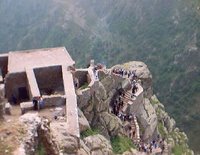Recent Archaeological Discoveries in Babak Fortress

LONDON, May 20, 2006 (CAIS) -- Following the recent excavations in Babak fortress and removal of debris, some important parts of the fortress, which had previously been unknown, were unearthed. Archaeological excavations in Babak Fortress started in 2002, and some parts of this fortress were unearthed. The most important discovery has recently been made in this historical site which was finding of a staircase dating back to the beginning of Post-Sasanid period.
The main activities of the excavation team were excavating and restoring the western part of the main staircase. Due to the large number of Iranian pilgrims, this part of the staircase was not in a good condition and if nothing had been done to preserve it, it would have suffered a real harm in the future.
A 4.5x5.5 meter room with two windows, which must have been a guard room, was discovered during latest excavations in. There is a 35-meter corridor beside the room. This corridor leads to two towers which have already been unearthed. The discovered staircase and the two-floor building at the back of the corridor and towers all belong to the beginning of the Islamic era. Experts believe that this building might have been a reservoir or food storage.
Stonework with mortar was used in the construction of this double-floor building, except for the staircase. This was a common architectural style during the Sasanid dynastic era. Therefore, it cannot be said for sure that the staircase and building were constructed during the same historical period. Babak fortress is one of the most important historical sites of Iran, located in a mountainous region in north-west of the country.
This fortress also called the Eternal Fortress was built during the Sasanid dynastic era; however, it is famous for the 23-year Iranian residence and resistance of Persian hero Babak Khorramdin who fought against the Arab invaders.
One of the most dramatic periods of Iranian history occurred under Babak’s leadership from 816 to 837 CE. Eventually Babak, his wife, and his warriors were forced to leave their command post at the fortress under very difficult circumstances after 23 years of struggle.
During Babak’s martyrdom, the caliph's henchmen first cut off his legs and hands in order to convey the most devastating message to Iranians. Legend has it that Babak bravely rinsed his face with the blood pouring out of his wounds, thus depriving the caliph and the rest of the Arab invaders the opportunity to see that his face had turned pale due to heavy bleeding.
Every year in July, Iranians pilgrims visiting the place to hail their Persian hero, Babak, as the symbol of Iranian resistance against foreign and dictatorship rules. The pilgrims reading poetry including Shahnameh (the Book of Kings - Iran’s most famous epic) and playing traditional Persian music. They also lit up bonfires to follow traditional rituals of ancient Iran.

3 Comments:
Wow that looks amazing, but i will never get up there, that place looks very fragile and say I'm gonna fall in any moment haha
I really like this site, it's so important to know more about this topic, keep it up and of course every time I have time I'll love to check out again
I'm truly enjoying the design and layout of your site. It's
a very easy on the eyes which makes it much
more pleasant for me to come here and visit more often.
Did you hire out a designer to create your theme?
Excellent work!
my web blog: airplane simulator games
Post a Comment
<< Home